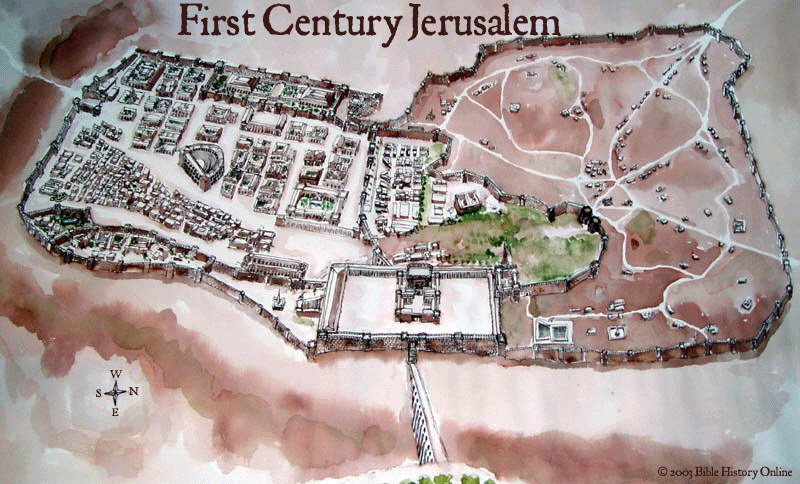First Century Jerusalem


Extract from www.bible-history.com /jerusalem /first century jerusalem_lower_city.html No visitor seeing Jerusalem for the first time could fail to be impressed by its visual splendor. The long, difficult ascent from Jericho to the Holy City ended as the traveler rounded the Mount of Olives, and suddenly caught sight of a vista like few others in the world. Across the Kidron Valley, set among the surrounding hills, was Jerusalem, "the perfection of beauty," in the words of Lamentations, "the joy of all the world." The view from the Mount of Olives was dominated by the gleaming, gold-embellished Temple which was located in the most holy spot in the Jewish world and really God's world. This was the Lord's earthly dwelling place, He mediated His throne here and raised up a people to perform rituals and ceremonies here that would foreshadow the coming of His Messiah kinsman redeemer who would be the lamb of God, slain for the sins of the whole world. The Temple stood high above the old City of David, at the center of a gigantic white stone platform. To the south of the temple (on the left hand side) was THE LOWER CITY, a group of limestone houses, yellow-brown colored from years of sun and wind. Narrow, unpaved streets and houses that sloped downward toward the Tyropean Valley, which ran through the center of Jerusalem. Rising upward to the west was THE UPPER CITY, or Zion, where the white marble villas and palaces of the very rich stood out like patches of snow. Two large arched passageways spanned the valley, crossing from the Upper City to the temple. A high, thick, gray stone wall encircled Jerusalem. It had been damaged, repaired and enlarged over the centuries, and in Jesus' day it was about 4 miles in circumference, bringing about 25,000 people into an area about a square mile. At intervals along the wall were massive gateways. Just inside each gate was a customs station, where publicans collected taxes on all goods entering or leaving the city. The New City in Jerusalem (on the right) Jerusalem was extended on its northwestern side and the inhabitants requested security, so Herod Agrippa I (circa 41 AD) built the third wall. the Pool of Bethesda was also located in the eastern portion of the New City, close to the Temple Mount. According to Josephus, there were three walls that surrounded Jerusalem, "90 towers stood in the first wall, 14 in the second, and 60 in the third." The First Wall The first wall was referred to as the "old wall" in the writings of Josephus and it encompassed the areas of the Lower and Upper Cities. It was originally built by one of the Hasmonean kings around 130 BC. The Second Wall The second wall is fairly uncertain due to lack of evidence, some say it began at the Citadel (the Tower of David in the west) and ran by the Damascus Gate (in the north) and formed a loop ending at the Antonia Fortress (in the east). The Third Wall The third wall began during the reign of Herod Agrippa I and evidence suggests that it was built around the new city from the Citadel around the northern Pool of Bethesda quarter forming a loop until it reached the Temple Mount.
Click here for "A Portrait Of Jesus' World - Jews And The Roman Empire"
** End of article